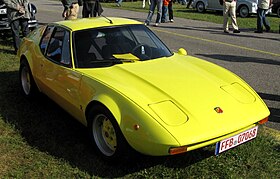Lombardi Grand Prix
| Lombardi Grand Prix | |
|---|---|
 |
|
| Overview | |
| Manufacturer | Carrozzeria Francis Lombardi |
| Production | 1968–1972 |
| Assembly | Vercelli, Italy |
| Designer | Giuseppe Rinaldi |
| Body and chassis | |
| Class | Sports |
| Body style | |
| Layout | Rear-engine, rear-wheel-drive |
| Powertrain | |
| Engine | |
| Transmission | 4-speed manual |
| Dimensions | |
| Wheelbase |
|
| Length |
|
| Width |
|
| Height |
|
| Curb weight | 630–750 kg (1,390–1,650 lb) |
The Lombardi Grand Prix is a small, rear-engined sports car on Fiat 850 underpinnings. It was developed by the Carrozzeria Francis Lombardi with an in-house design by Giuseppe Rinaldi. The car was built from 1968 until 1972 and was also marketed as the OTAS 820, as a Giannini, and as the Abarth Grand Prix and Scorpione. It was first shown in March 1968, at the Geneva Motor Show. The design had a Kammback rear and a very low nose with flip-up headlights, and a large single windshield wiper. The headlights were electrically powered. The bodywork was all steel, except the rear panel. The design was originally shown as a prototype based on the front-wheel drive Autobianchi A112, and was adapted by Lombardi for the 850 sedan's floorpan. At Turin 1969 a targa version was also shown; called the "Monza", this open model has a rollover bar. At least two were built but it is unknown whether any were sold.
The original Lombardi Grand Prix as presented had the regular 843 cc Fiat 850 engine with 37 PS (27 kW) DIN at 5000 rpm (43 hp SAE), coupled to a four-speed gearbox. Low drag resistance and weight (630 kg or 1,390 lb) meant that this was supposedly enough for a top speed of 160 km/h (99 mph). Later production models had the 850 Special engine, with 47 PS (35 kW) at 6400 rpm - in a period German test the maximum speed of the more powerful variant was 153.8 km/h (95.6 mph). Luggage space is limited, with very little space next to the spare wheel up front and with a tiny area behind the seats. In case the electric wind-up mechanism for the headlights should fail, there is also a mechanical lever underneath the bonnet. The single round tail lights are Fiat 850 Coupé units. The front suspension consists of a transverse leaf spring on the bottom and A-arms on top, while the rear received coil sprung semi-trailing arms.
The Lombardi Grand Prix was built in two series: early models used the regular, metal engine cover from the Fiat 850 while the Series II has a louvred unit in black metal. The door windows are also different, being of a three-piece design (one on top, two lower pieces of which one could be slid open) while later cars have a more conventional layout with a vent window up front and a single piece which, however, could only be rolled halfway down.
A Cypriot casino owner and millionaire had also shown interest in the Lombardi Grand Prix around the time of its introduction. Frixos Demetriou intended to market the car in the United Kingdom and began planning for an order of 1000 cars. After his death in a British Army tank accident in Cyprus, this project came to a sudden halt. Only ten cars were imported into the UK, with the remaining parts languishing in storage in Turin. A few unsold cars were re-exported to Cyprus in 1969 to avoid pending customs bills.
...
Wikipedia
